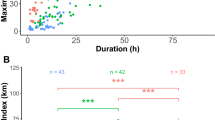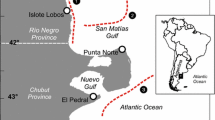Abstract
During the day, the diadematid sea urchin Centrostephanus coronatus occupies holes and crevices in shallow subtidal rocky substrata. Individuals emerge from these after sunset and forage on organisms attached to the surrounding rock surface. Each urchin travels <1 m from its shelter and returns to the same one before sunrise. The sheephead wrasse Pimelometopon pulchrum does not remove urchins from their shelters, but will attack and consume urchins placed in normal feeding locations during the daytime. The active periods of the sheephead and the urchin do not overlap; urchins begin foraging about 20 min after the diurnal sheephead retire in the evening and return to their shelters 1 to 2 h before sheephead resume feeding in the morning. We infer that the urchin's daytime crevice-dwelling and nocturnal foraging habits have evolved as a response to sheephead predation. Moreover, because shelters are limited in supply, shelter fidelity may have evolved to insure refuge from sheephead.
Similar content being viewed by others
Literature Cited
Birkeland, C. and B.D. Gregory: Feeding behavior of a tropical predator Cyphoma gibbosum Linnaeus. In: Tektite 2. Scientists in the sea, pp VI-58 to VI-69. Ed. by J.W. Miller and J.G. Vanderwalker. Washington: U.S. Department of the Interior 1971
Cloudsley-Thomas, J.L.: Adaptive functions of circadian rhythms. Cold Spring Harb. Symp. quant. Biol. 25, 345–355 (1960)
Dart, J.K.G.: Echinoids, algal lawn and coral recolonization. Nature, Lond. 239, 50–51 (1972)
Ebert, E.E.: A food habits study of the southern sea otter, Enhydra lutris nereis. Calif. Fish Game 54, 33–42 (1968)
Ebling, F.J., A.D. Hawkins, J.A. Kitching L. Muntz and V.M. Pratt: The ecology of Lough Ine. XVI. Predation and diurnal migration in the Paracentrotus community. J. Anim. Ecol. 35, 559–566 (1966)
Estes, J.A. and J.F. Palmisano: Sea otters: their role in structuring nearshore communities. Science, N.Y. 185, 1058–1060 (1974)
Finstad, W.O. and D.R. Nelson: Circadian activity rhythm in the horn shark, Heterodontis francisci: effect of light intensity. Bull. Sth. Calif. Acad. Sci. 74, 20–26 (1975)
Fricke, H.W.: Fische als Feinde tropischer Seeigel. Mar. Biol. 9, 328–338 (1971)
— Möglicher Einfluß von Feinden auf das Verhalten von Diadema-Seeigeln. Mar. Biol. 27, 59–62 (1974)
Grünbaum, H., G. Bergman, D.P. Abbott and J.C. Ogden: Intraspecific agonistic behavior in the rock-boring sea urchin Echinometra lucunter (L.) (Echinodermata: Echinoidea). Bull. mar. Sci. 28 181–188 (1978)
Hobson, E.S.: Predatory behavior of some shore fishes in the Gulf of California. Res. Rep. U.S. Fish Wild. Serv. 73, 1–92 (1968)
— Activity of Hawaiian reef fishes during the evening and morning transitions between daylight and darkness. Fish. Bull. U.S. 70, 715–740 (1972)
— Diel feeding migrations in tropical reef fishes. Helgoländer wiss. Meeresunters. 24, 361–370 (1973)
— Feeding relationships of teleostean fishes on coral reefs in Kona, Hawaii. Fish. Bull. U.S. 72, 915–1031 (1974)
— and J.R. Chess: Trophic interactions among fishes and zooplankters near shore at Santa Catalina Island, California. Fish. Bull. U.S. 74, 567–598 (1976)
Kitching, J.A., J.F. Sloane and F.J. Ebling: The ecology of Lough Ine. VIII. Mussels and their predators. J. Anim. Ecol. 28, 331–341 (1959)
Lawrence, J.M.: On the relationships between marine plants and sea urchins. Oceanogr. mar. Biol. A. Rev. 13, 213–286 (1975)
— and L. Hughes-Games: The diurnal rhythm of feeding and passage of food through the gut of Diadema setosum (Echinodermata: Echinoidea). Israel J. Zool. 21, 13–16 (1972)
Leighton, D.L., L.G. Jones and W.J. North: Ecological relationships between giant kelp and sea urchins in Southern California. Proc. int. Seaweed Symp. 5, 141–153 (1966). (Ed. by E.G. Young and J.L. McLachlan. Oxford: Pergamon Press)
Lissner, A.L.: Factors affecting the distribution and abundance of the sea urchin Centrostephanus coronatus Verrill at Santa Catalina Island, 168 pp. Ph.D. dissertation, University of Southern California 1978
Lowry, L.F. and J.S. Pearse: Abalones and sea urchins in an area inhabited by sea otters. Mar. Biol. 23, 213–219 (1973)
Magnus, D.B.E.: Der Federstern Heterometra savignyi im Roten Meer. Natur Mus., Frankf. 93, 355–368 (1963)
— Ecological and ethological studies and experiments on the echinoderms of the Red Sea. Stud. trop. Oceanogr. 5, 635–664 (1967)
Miller, D.J.: The sea otter Enhydra lutris: its life history, taxonomic status, and some ecological relationships. Mar. Resour. Leafl., St. Calif., Resour. Ag., Dep. Fish Game 7, 1–13 (1974). (Copies available from: Marine Resources Region, 350 Golden Shore, Long Beach, Calif. 90802, USA)
Millott, N.: Light emission and light perception in species of Diadema. Nature, Lond. 171, 973–974 (1953)
— Sensitivity to light and the reactions to changes in light intensity of the echinoid Diadema antillarum Philippi. Phil. Trans. R. Soc. (Ser. B) 238, 187–220 (1954)
Moore, H.B.: Ecology of echinoids. In: Physiology of Echinodermata, pp 73–85. Ed. by R.A. Boolootian. New York: Wiley-Interscience 1966
Muntz, L., F.J. Ebling and J.A. Kitching: The ecology of Lough Ine. XIV. Predatory activities of large crabs. J. Anim. Ecol. 34, 315–329 (1965)
North, W.J. (Ed.): Kelp habitat improvement project, Annual Report 1964–1965, 70 pp. Pasadena, Calif.: California Institute of Technology 1965
— and J.S. Pearse: Sea urchin population explosion in southern California coastal waters. Science, N.Y. 167, p. 209 (1970)
Ogden, J.C., R.A. Brown and N. Salesky: Grazing by the echinoid Diadema antillarum Philippi: Formation of halos around West Indian patch reefs. Science, N.Y. 182, 715–716 (1973)
Paine, R.T.: Intertidal community structure. Experimental studies on the relationship between a dominant competitor and its principal predator. Oecologia 15, 93–120 (1974)
Palmisano, J.F. and J.A. Estes: Sea otters: pillars of the nearshore community. Nat. Hist., N.Y. 85(7), 46–53 (1976)
Pearse, J.S.: A monthly reproductive rhythm in the diadematid sea urchin Centrostephanus coronatus Verrill. J. exp. mar. Biol. Ecol. 8, 167–186 (1972)
— and S.W. Arch: The aggregation of Diadema (Echinodermata: Echinoidea). Micronesica 5, 165–171 (1969)
— and R.W. Timm: Juvenile nematodes (Echinocephalus pseudouncinatus) in the gonads of sea urchins (Centrostephanus coronatus) and their effect on host gametogenesis. Biol. Bull. mar. biol. Lab., Woods Hole 140, 95–103 (1971)
Pianka, E.R.: Evolutionary ecology, 356 pp. New York: Harper & Row 1974
Randall, J.E., R.E. Schroeder and W.A. Starck: Notes on the biology of the echinoid Diadema antillarum. Caribb. J. Sci. 4, 421–433 (1964)
Sharp, D.T. and I.E. Gray: Studies on factors affecting the local distribution of two sea urchins, Arbacia punctulata and Lytechinus variegatus. Ecology 43, 309–313 (1962)
Sinclair, A.N.: Observations on the behavior of sea urchins. Aust. Mus. Mag. 13, 3–8 (1959)
Smith, D.P.: Daily migrations of tropical sea urchins. Am. Zool. 9, p. 1075 (1969)
Taylor, L.R.: A revision of the shark family Heterodontidae (Heterodontiformes, Selachii), 189 pp. Ph.D. dissertation, University of California at San Diego 1972
Thornton, I.W.B.: Diurnal migrations of the echinoid Diadema setosum (Leske). Br. J. Anim. Behav. 4, 143–146 (1956)
Vance, R.R.: Effects of grazing by the sea urchin, Centrostephanus coronatus, on prey community composition. Ecology (in press)
Word, J.Q.: Key to the regular urchins. In: Invertebrates of Southern California coastal waters. I. Select groups of annelids, arthropods, echinoderms, and molluscs, pp 109–110. Ed. by J.Q. Word and D.K. Charwat. Southern California Coastal Water Research Project (SCCWRP) 1975. (Copies available from: SCCWRP, 1500 East Imperial Highway, El Segundo, Calif. 90245, USA)
Zaret, T.M. and J.S. Suffern: Vertical migration in zooplankton as a predator avoidance mechanism. Limnol. Oceanogr. 21, 804–813 (1976)
Author information
Authors and Affiliations
Additional information
Communicated by N.D. Holland, La Jolla
Rights and permissions
About this article
Cite this article
Nelson, B.V., Vance, R.R. Diel foraging patterns of the sea urchin Centrostephanus coronatus as a predator avoidance strategy. Mar. Biol. 51, 251–258 (1979). https://doi.org/10.1007/BF00386805
Accepted:
Issue Date:
DOI: https://doi.org/10.1007/BF00386805




